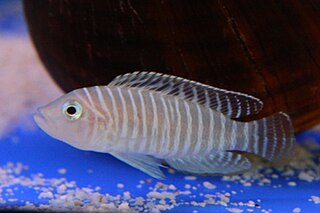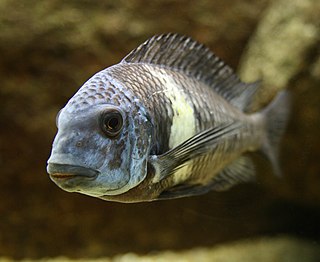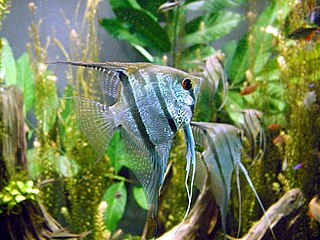
The rosy barb is a subtropical freshwater cyprinid fish found in southern Asia from Afghanistan to Bangladesh.
The shortfin barb is a species of cyprinid fish native to southern Africa where it occurs in the Sabie-Komati and the Steelpoort-Limpopo river systems. It inhabits well vegetated headwater streams. This species can reach a length of 4.5 centimetres (1.8 in) SL. It can also be found in the aquarium trade.

Neolamprologus similis is a shell-dwelling cichlid endemic to Lake Tanganyika where it is only known along the shores of the Democratic Republic of the Congo. N. similis is copper coloured with vertical white stripes running from the head to near the base of the tail. It can reach up to 5 centimetres (2.0 in) in total length. It is a popular freshwater aquarium fish.

The melon barb is a common species of cyprinid fish that is endemic to rivers in Goa, Karnataka, Kerala and Tamil Nadu in the Western Ghats of South India. They live in a tropical climate in water that typically has a pH of 6.0—6.5, a water hardness of around 5 dGH, and a temperature range of 22–26 °C (72–79 °F). This species can also be found in the aquarium trade.

Tropheus is a small genus of six species of cichlids endemic to Lake Tanganyika in East Africa. The genus is widespread across all regions of Lake Tanganyika, from Burundi in the north to Zambia in the south. Males and females are relatively similar, but do display obvious sexual dimorphism. Males attain a somewhat larger size. All species maternally mouthbrood their eggs and fry, and this characteristic provides their generic name. Tropheus comes from the Greek trophos, which means "to nurse" or, according to Boulenger, "one who rears, brings up, educates". The genus is fished lightly by the local population, but has never become a staple food fish due to its relatively small size and its habitat, which enables it to dart between rocks when threatened.

Hypsophrys is a small genus of cichlid fishes from Central America.

The African lanternshark is a shark of the family Etmopteridae found in the eastern Atlantic between latitudes 12°N and 18°S, at depths between 300 and 1,000 m. Its length is up to 30 cm.

Hypsophrys nicaraguensis, the moga, is a species of cichlid endemic to the Atlantic slope of Central America, from Nicaragua to Costa Rica. The species is a popular aquarium fish and is traded under a variety of common names that include Nickie, Parrot cichlid, Macaw Cichlid, Butterfly Cichlid and Nicaraguense.

Mesonauta, the flag cichlids, is a small genus of cichlids native to the Amazon, Orinoco, Essequibo, Paraná and Paraguay basins in South America. Mesonauta is included in the subfamily Cichlasomatinae. They occur in various freshwater habitats such as streams and lakes, especially in areas with little water movement and aquatic vegetation. They are generally found in small groups that stay near the water surface. To avoid predators, adults may jump out of the water and juveniles mimic leaves.

Brachygobius is a small genus of gobies. They are popular aquarium fish where a number of species are sold as bumblebee gobies because their colours are similar to those of bumblebees.
Placidochromis polli is a species of cichlid endemic to the southern portions of Lake Malawi where it prefers areas with muddy or sandy substrates at depths of greater than 75 metres (246 ft). This species can reach a length of 14.9 centimetres (5.9 in) SL. Its specific hame honours the Belgian ichthyologist Max Poll (1908-1991).

Petrochromis polyodon is a species of cichlid endemic to Lake Tanganyika found in areas with rocky substrates where it can graze on algae. This species coexists with other herbivorous cichlids such as Tropheus moorii and Telmatochromis temporalis. Individuals can reach lengths of 21 cm (8.3 in). They can be found in the aquarium trade.

Tropheus annectens is a species of cichlid endemic to Lake Tanganyika, where it is found on a substrate consisting of large, fixed rock. This species can reach a length of 8 cm (3.1 in). It can be found in the aquarium trade.
Tropheus brichardi is a species of cichlid endemic to Lake Tanganyika where it is found in areas with substrates of solid rock in the central portion of the lake. This species can reach a length of 10 cm (3.9 in). It can be found in the aquarium trade. The specific name honours Pierre Brichard (1921-1990) the aquarium fish exporter who provided the authors with the type.

Tropheus duboisi, the white spotted cichlid, is a species of cichlid endemic to Lake Tanganyika. It can reach a length of 12 cm (4.7 in).
Tropheus kasabae is a species of cichlid endemic to Lake Tanganyika where it is found in areas with rocky substrates in the southern portion of the lake. This species can reach a total length of 11.1 cm (4.4 in). It can be found in the aquarium trade.

Microsynodontis is a genus of upside-down catfishes native to freshwater rivers in western Africa. The genus was originally described by British-Belgian zoologist George Albert Boulenger in 1903 based upon the type species Microsynodontis batesii. The name microsynodontis comes from the Greek word mikro, meaning small, and the Greek term synodon, meaning "with the teeth all growing together".
Shrimp mix, also known as European shrimp mix, is a frozen fish feed used for fish with special dietary requirements, e.g. Tropheus, which are difficult to maintain using normal fish feed. The basic version is intended for herbivorous fish and is made by blending equal amounts of whole shrimp and green peas to a smooth paste, adding a vitamin supplement, and using either agar-agar or gelatin as binder. There are numerous variants tailored to the specific needs of different species. Common variants replace part of the shrimp or peas with fish meat, spinach, spirulina, or mussel meat, and add astaxanthin, ascorbic acid, or garlic.















